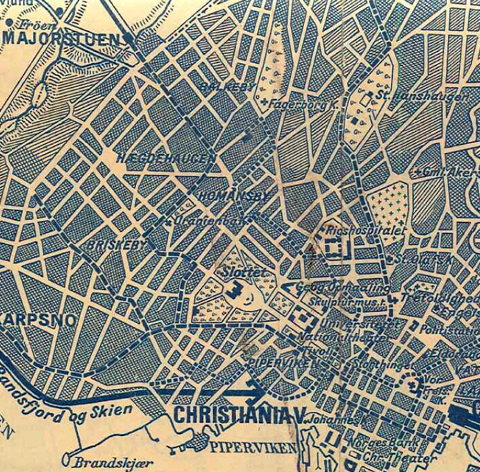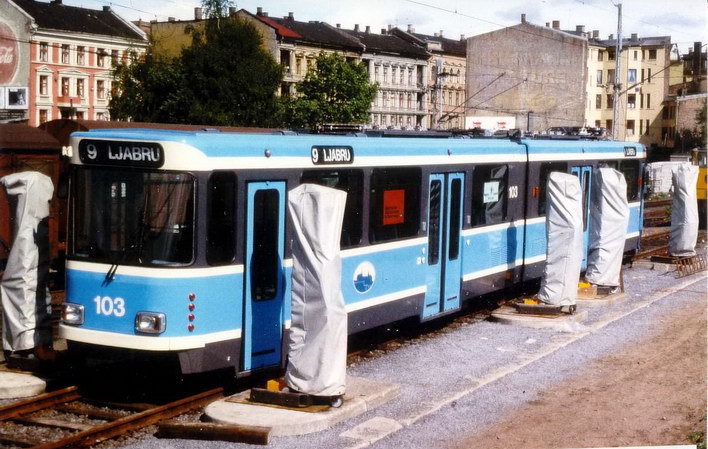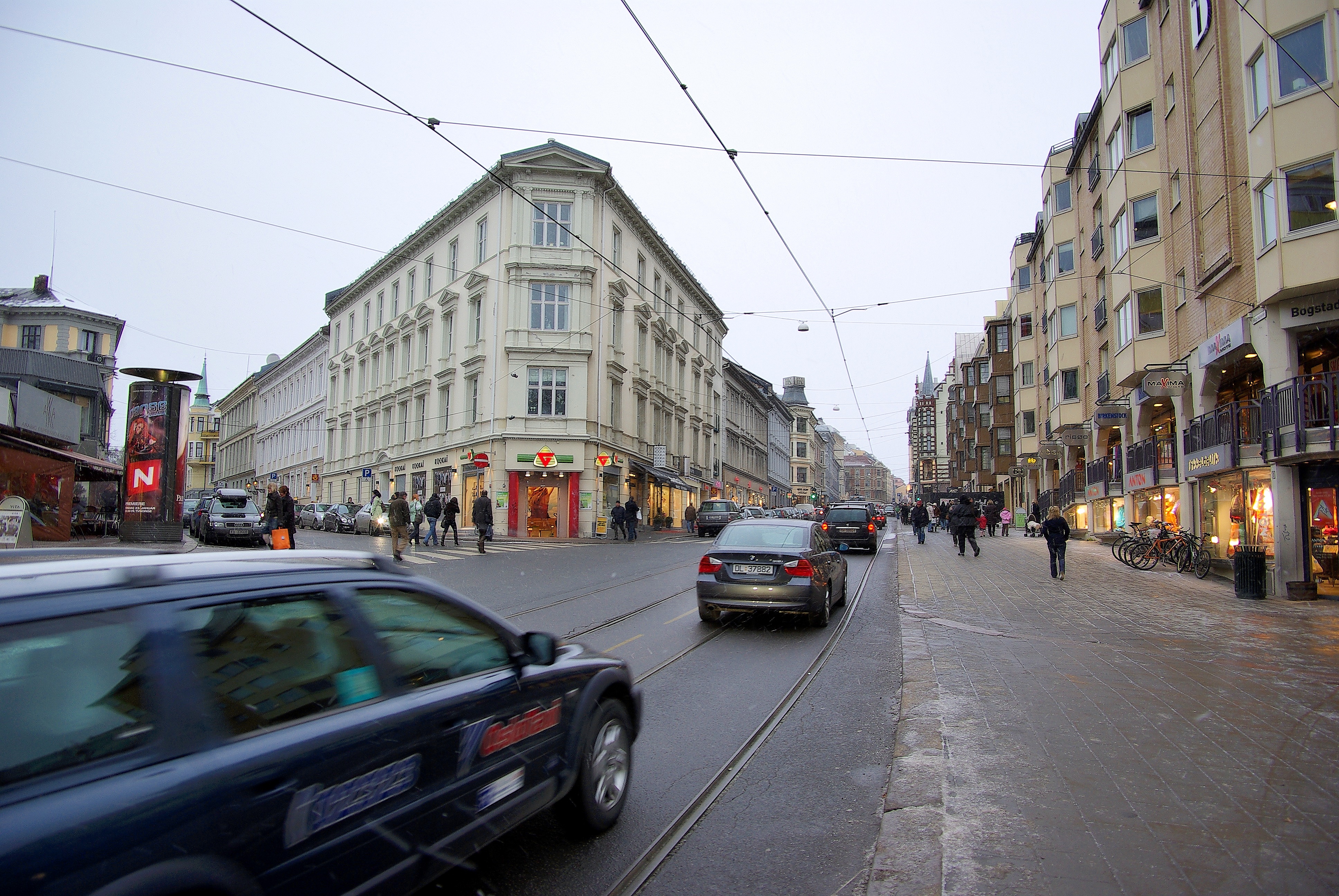|
Briskeby Line
The Briskeby Line ( no, Briskebylinjen) is a line of the Oslo Tramway in Norway. It runs westwards from Jernbanetorget in the city center, passing through the neighborhoods of Briskeby and Uranienborg before reaching its terminus at Majorstuen. The section from Jernbanetorget to Inkognitogata is shared with the Skøyen Line; on this section it connects with the important transport hub Nationatheatret. This part is variously served by route 11, 12 and 13. From the Inkognitogata stop, the line moves through the residential areas around the Royal Palace, in the streets named Riddervolds gate, Briskebyveien, Holtegata and Bogstadveien. The part of the line in Bogstadveien from Majorstuen to Rosenborg is also served by route 19, which operates the Homansbyen Line. When Kristiania Elektriske Sporvei opened the line on 3 March 1894, it was the first electric tramway in Scandinavia. Originally the line ran through Parkveien instead of Inkognitogata and was mostly single track. The trac ... [...More Info...] [...Related Items...] OR: [Wikipedia] [Google] [Baidu] |
SL79
SL79 is a class of 40 articulated trams operated by the Oslo Tramway of Norway. The trams were a variation of the Duewag trams that had been developed by the German manufacturer since the 1950s. The six-axle vehicles are unidirectional with four doors on the right side. The trams can seat 77 passengers three and four abreast, with an additional 91 people able to stand. Power output is , provided by two motors on the two end bogies, that supplement a central unpowered Jacobs bogie located under the articulation. The trams are long and wide. They are capable of and have standard gauge. They were built in two series, the first of 25 units delivered in 1982–84, and the second of 15 units delivered in 1989–90. The first 10 units were built by Duewag, while the last 30 were built in Norway by Strømmen. They were numbered 101 through 140. The two series vary slightly in specifications. The trams were ordered in 1979 after the 1977 decision to not close the tramway, after the SM5 ... [...More Info...] [...Related Items...] OR: [Wikipedia] [Google] [Baidu] |
Uranienborg, Norway
Uranienborg is a neighborhood in the borough of Frogner in Oslo, Norway. History Originally a rural area in the former municipality Aker, it was incorporated into the city of Christiania (later Oslo) in 1859. The property used to have a wonderful view, and it was therefore named after the famous observatory Uranienborg at the island of Ven. It received public transport with the Briskeby Line. From 1988 to 2004 it formed the borough ''Uranienborg-Majorstuen'' together with Majorstuen; in 2004 it was incorporated into Frogner borough. It includes Roald Amundsen's Home, also known as "Uranienborg", the home of the polar explorer from 1908, before his successful South Pole expedition, until his death in 1928. The home is now a historic site and tourist attraction. Uranienborg Park Uranienborg is the site of Uranienborgparken, the park where Uranienborg Church is located. The park contains a bronze statue of the Lutheran church reformer Hans Nielsen Hauge. The church is noted fo ... [...More Info...] [...Related Items...] OR: [Wikipedia] [Google] [Baidu] |
Ruter
Ruter AS is the public transport authority for Oslo and Akershus counties in Norway. Formally a limited company – 60% of its shares are owned by the Oslo county municipality and 40% by that of Akershus – it is responsible for the administration, funding, and marketing (but not direct operation) of public transport in the two counties, including buses, the Oslo Metro (''T-banen i Oslo''), Oslo Trams (''Trikken i Oslo''), and ferry services. Ruter also holds agreements with Norwegian State Railways concerning the regulation of fares on local and regional train services operated within the two counties. Operation The operation of services is performed by other companies: *Bus routes are subject to public service obligation, and operators include UniBuss, Nettbuss, Norgesbuss, Schau's Buss, and Nobina Norge. *The metro system is operated by Sporveien T-banen while the tramway is operated by Sporveien Trikken, both subsidiaries of the municipally owned Sporveien Oslo A ... [...More Info...] [...Related Items...] OR: [Wikipedia] [Google] [Baidu] |
Oslo Sporveier
AS Oslo Sporveier is a defunct municipal owned company responsible for public transport in Oslo, Norway. It was created in 1924 to take over the city's two private tram companies. In 1927 its started with bus transport, including from 1940 to 1968 trolleybuses. Since 1966 rapid transit and from 1985 water buses have also been operated by the company. It was split into two separate companies in 2006; Kollektivtransportproduksjon took over the operation while Oslo Public Transport Administration (who retained the Oslo Sporveier brand) was responsible for buying the services, fare regulation and marketing. The latter merged into Ruter in 2008, when the Oslo Sporveier brand was discontinued. History It all started with trams In 1875, Kristiania Sporveisselskab (KSS) started the first horsecar services in Oslo—at the time called Kristiania. It was followed by Kristiania Elektriske Sporvei (KES) who established electric tram services in 1894; by 1900 KSS had also converted its ro ... [...More Info...] [...Related Items...] OR: [Wikipedia] [Google] [Baidu] |
Ullevål Hageby Line
The Ullevål Hageby Line ( no, Ullevål Hageby-linjen) is a light rail section of the Oslo Tramway. It runs from Stortorvet in the city center of Oslo, Norway to Rikshospitalet. It passes through the areas of St. Hanshaugen, Ullevål Hageby and Blindern before reaching Gaustad. It serves major institutions such as Oslo University College, Bislett Stadion, Ullevål University Hospital, the University of Oslo and Rikshospitalet. The line is served by route 17 and 18 by Oslo Sporvognsdrift using SL95 trams, while the tracks are owned by Kollektivtransportproduksjon. The first section, from Stortorvet from Homansbyen, opened in 1875 as a horsecar line. It was electrified in 1900, and extended to Adamstuen in 1909. In 1925, the line reached Ullevål Hageby. The final extension to Rikshospitalet was opened in 1999, following the move of the hospital. The last section is formally called the Gaustad Line (''Gaustadlinjen''). North of Adamstuen, the line runs in its own right-of-way ... [...More Info...] [...Related Items...] OR: [Wikipedia] [Google] [Baidu] |
Right Of Way Trail
A rail trail is a shared-use path on railway right of way. Rail trails are typically constructed after a railway has been abandoned and the track has been removed, but may also share the right of way with active railways, light rail, or streetcars (rails with trails), or with disused track. As shared-use paths, rail trails are primarily for non-motorized traffic including pedestrians, bicycles, horseback riders, skaters, and cross-country skiers, although snowmobiles and ATVs may be allowed. The characteristics of abandoned railways—gentle grades, well-engineered rights of way and structures (bridges and tunnels), and passage through historical areas—lend themselves to rail trails and account for their popularity. Many rail trails are long-distance trails, while some shorter rail trails are known as greenways or linear parks. Rail trails around the world Americas Bermuda The Bermuda Railway ceased to operate as such when the only carrier to exist in Bermuda folded in 1948. ... [...More Info...] [...Related Items...] OR: [Wikipedia] [Google] [Baidu] |
Double-track Railway
A double-track railway usually involves running one track in each direction, compared to a single-track railway where trains in both directions share the same track. Overview In the earliest days of railways in the United Kingdom, most lines were built as double-track because of the difficulty of co-ordinating operations before the invention of the telegraph. The lines also tended to be busy enough to be beyond the capacity of a single track. In the early days the Board of Trade did not consider any single-track railway line to be complete. In the earliest days of railways in the United States most lines were built as single-track for reasons of cost, and very inefficient timetable working systems were used to prevent head-on collisions on single lines. This improved with the development of the telegraph and the train order system. Operation Handedness In any given country, rail traffic generally runs to one side of a double-track line, not always the same side a ... [...More Info...] [...Related Items...] OR: [Wikipedia] [Google] [Baidu] |
Single Track (rail)
A single-track railway is a railway where trains traveling in both directions share the same track. Single track is usually found on lesser-used rail lines, often branch lines, where the level of traffic is not high enough to justify the cost of constructing and maintaining a second track. Advantages and disadvantages Single track is significantly cheaper to build and maintain, but has operational and safety disadvantages. For example, a single-track line that takes 15 minutes to travel through would have capacity for only two trains per hour in each direction safely. By contrast, a double track with signal boxes four minutes apart can allow up to 15 trains per hour in each direction safely, provided all the trains travel at the same speed. This hindrance on the capacity of a single track may be partly overcome by making the track one-way on alternate days, if the single track is not used for public passenger transit. Long freight trains are a problem if the passing s ... [...More Info...] [...Related Items...] OR: [Wikipedia] [Google] [Baidu] |
Kristiania Elektriske Sporvei
A/S Kristiania Elektriske Sporvei or KES, nicknamed the Blue Tramway ( no, Blåtrikken), was a company which operated part of the Oslo Tramway between 1894 and 1924. It built a network of four lines in Western Oslo, the Briskeby Line and the Frogner Line which ran to Majorstuen, and two other consecutive lines, the Skøyen Line and the Lilleaker Line. These all connected to a common line through the city center which terminated at Jernbanetorget. KES was established as the second tram operator in Oslo (then known as Kristiania). When it commenced services it was the first electric tramway in Scandinavia. It originally opened the Briskeby Line and the Skøyen Line to Skillebekk using a fleet of Class A trams. Later the company also ordered Class U and Class SS trams, for a total 78 motor cars and 66 trailers. Skøyen was reached in 1903. The first part of the Frogner Line opened in 1902, and it was completed in 1914. The Lilleaker Line was built to Lilleaker in 1919. KES and i ... [...More Info...] [...Related Items...] OR: [Wikipedia] [Google] [Baidu] |
Homansbyen Line
Homansbyen is a tram stop located at Homansbyen in Frogner borough of Oslo, Norway. It is on the Homansbyen Line, a short line that connects the Briskeby Line and Ullevål Hageby Line of Oslo Tramway, and is served by line 19 using SL79 trams. This line is the shortest of the three tram lines that connect the city centre with Majorstuen. The city has planned to build a new rapid transit station for the Oslo T-bane at Homansbyen, but as of 2017 this has not been developed. Tram station Homansbyen was opened on 10 October 1875, as the terminus of the first horsecar line built by Kristiania Sporveisselskab. The station became a branch of the main Ullevål Hageby Line when a connection was built between it and the Kristiania Elektriske Sporvei-owned Briskeby Line on 1 May 1912. In 2002, Oslo Sporveier decided to close Homansbyen Line from 12 April 2003 due to financial difficulties, and reroute the 11-tram to the Ullevåll Hageby Line instead. However, a city grant on 8 April 2003 ... [...More Info...] [...Related Items...] OR: [Wikipedia] [Google] [Baidu] |
Bogstadveien
Bogstadveien is a street in the district of Frogner in Oslo, Norway. It is considered a central business district and features many of the city's wide range of exclusive shops as well as entertainment, hotels and restaurants. The road is known for the frequent Farmer's Markets on weekends as well as its biannual car-free shopping events. Bogstadveien stretches from the neighbourhood Majorstuen to the neighbourhood Hegdehaugen. The street was originally named Sørkedalsveien as it led to Sørkedalen, but was renamed to Bogstadveien when, in 1878, it was incorporated into Oslo. It was named for the Bogstad Manor in Sørkedalen. In 1892, the street was extended in width to serve as the main street towards Majorstuen. On 2 March 1894, the first electric tramway line in Oslo, the Briskeby Line, was opened. The line runs through almost the entirety of the street, and has a single stop named for it, located by the street junction with Industrigaten. Previously the street was served b ... [...More Info...] [...Related Items...] OR: [Wikipedia] [Google] [Baidu] |
Royal Palace, Oslo
The Royal Palace ( no, Slottet or ''Det kongelige slott'') in Oslo was built in the first half of the 19th century as the Norwegian residence of the French-born King Charles III John, who reigned as king of Norway and Sweden. The palace is the official residence of the current Norwegian monarch while the Crown Prince resides at Skaugum in Asker west of Oslo. The palace is located at the end of Karl Johans gate in central Oslo and is surrounded by the Palace Park with the Palace Square in the front. History Until the completion of the palace, Norwegian royalty resided in Paléet, the magnificent townhouse in Christiania that the wealthy merchant Bernt Anker bequeathed to the State in 1805 to be used as a royal residence. During the last years of the union with Denmark Paléet was used by the viceroys of Norway, and in 1814 by the first king of independent Norway, Christian Frederick. King Charles III John of the House of Bernadotte resided there as crown prince and later a ... [...More Info...] [...Related Items...] OR: [Wikipedia] [Google] [Baidu] |







.jpg)